|
Recent Entries to this Blog
My mother, as a young girl, loses her father then her mother
Posted: 23 Dec 2019 Posted: 12 Dec 2019 Posted: 28 Jul 2017 Posted: 20 Feb 2017 Posted: 03 Dec 2016 All Entries |
Raddang's Blog
My mother, as a young girl, loses her father then her mother
Category: That's life | Posted: Mon Dec 23, 2019 6:30 pm 2 My mother, as a young girl, loses her father and then her mother In my first story in this series of family history recollections, I told of my maternal grandfather dying at sea shortly after the start of WWI. My mother at that time was just days short of her first birthday. My grandmother already had two sons and a daughter so was then a widow with four young children to support. 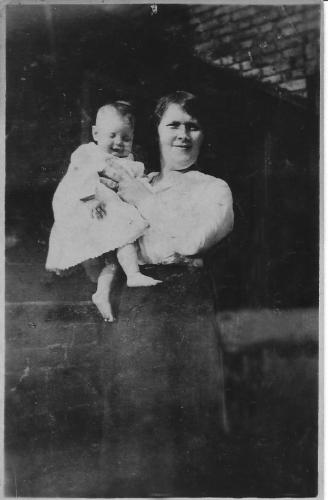
My grandmother with my mother c1914 ( photo / image / picture from Raddang's Garden ) I missed the opportunity to talk to my mother about her life before she married my father. Her widowed mother remarried when my mother was 8 years old. When my mother was still only 14 years of age, her mother died at the young age of 41 for reasons still unknown to me. So my mother was now without either parent and from what little I remember, she went 'into service'. This was very common for young girls from families of modest means. This would mean that she would 'live in' as a servant with a family and do many household chores. I have a record of one great aunt who was 'in service' at the age of 12 years. The master and mistress were just 24 years old with two children. He was A Carrier, which probably meant he had a horse and cart to carry and deliver goods. This gave him an income which allowed him to employ servants. This was in Victorian times and as servants they, 'Lived In with all found' and were rewarded with a very small annual salary. I can well imagine that when my mother met my father, a proposal of marriage was happily accepted to gain her release from service. She married my father just 4 months after her twentieth birthday, and I was born just 10 months later. 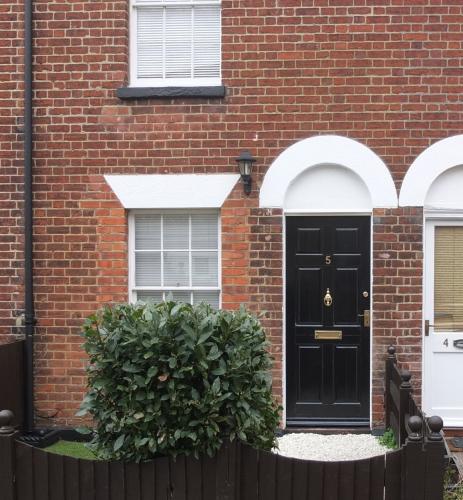
My pre-WWII home ( photo / image / picture from Raddang's Garden ) This blog entry has been viewed 305 times
Comments (0) | Leave a Comment | Permalink
Stories from my family history research
Category: That's life | Posted: Thu Dec 12, 2019 4:08 pm Today is General Election day in the UK but, as my wife and I use postal voting, we didn't need to venture out on a cold and rainy day to the Polling Station. On Sjoerds thread about his city I mentioned that I have been spending some time on family history. As a member of Ancestry I have access to many national records which, coupled with links to other members' trees, means that ones 'tree' can be enhanced and in the process many stories emerge. I thought that I would relate a few here, some sad and some poignant, but underlying they help to create a picture of life in times gone by. I will break this into individual short stories 1 Links to my maternal grandfather live on My mother was born on September 30 1913. She had 2 older brothers and a sister at that time. Her father was an oyster fisherman and a Royal Nany reserve seaman. WWI was declared on 28 July 1914 and my grandfather was 'called up' in August 1914. He was drafted to HMS Cressy which was torpedoed by a German submarine early on the morning of 22 September 1914, just a few weeks after his call up. He drowned along with many shipmates just 8 days before my mothers first birthday and leaving a widow and four young children My maternal family are mostly from the north Kent coast, in particular Whitstable, a lovely little harbour town just 7 miles from where I live now. Some years ago when walking along the coastal path I came across an old oyster fishing yawl, Favourite, which was built in 1890. It is the last surviving of more than 100 yawls that fished off Whitstable in the 19th and early 20th centuries. She is now the subject of a preservation scheme and I remember just leaning over and touching this relic of a gone by era. Little did I know that much more recently when I acquired a copy of my grandfathers RNR service record that he is listed as serving as an oyster dredger on F69 Favourite. And it is quite likely that I touched the gunwale in the same spot as my grandfather had touched more than 100 years ago. My photo of F69 Favourite 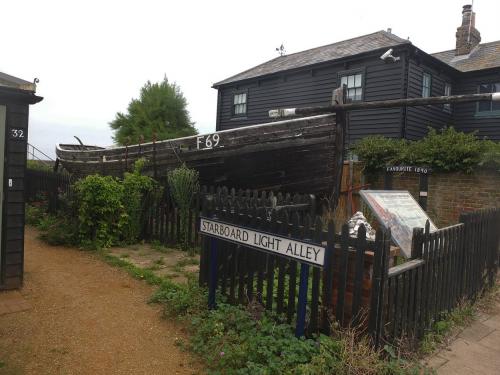
( photo / image / picture from Raddang's Garden ) Last edited: Thu Dec 12, 2019 11:18 pm This blog entry has been viewed 307 times
Comments (0) | Leave a Comment | Permalink
Some Pubs and their Pub Signs
Category: The County of Kent and Beyond | Posted: Fri Jul 28, 2017 10:11 pm Pubs and Pub Signs A couple of years ago I set myself the task of photographing the exteriors and signs of all pubs in the city of Canterbury. A search on the local council licensing page showed 47 establishments that could be described as a pub (A Public House that serves alcoholic drinks). There used to be many more but most of those have converted back to private residences or restaurants.. There are hundreds of other 'licensed' premises but I was just interested in pubs and their signs. There are more than the 47 that I noted above but most are New Style pubs with contemporary interiors and plain boring signs with equally boring names. A case in point is a pub right opposite the military barracks. It was a traditional pub called The Grenadier with a splendid painted sign of a grenadier soldier in full uniform. It is now called Run of the Mill with a plain grey board for a sign with just the name printed on it. I have so far only recorded 30 and from those I have selected 12 that represent the range of pubs both within and outside the city wall. 1 The Millers Arms This pub was built in 1826 right opposite a newly built mill to serve the mill workers. It is just inside the old city wall to the north of the city. 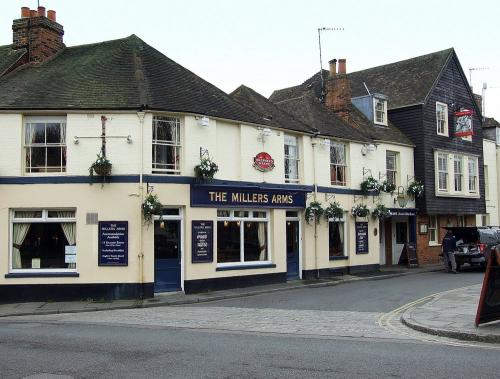
( photo / image / picture from Raddang's Garden ) 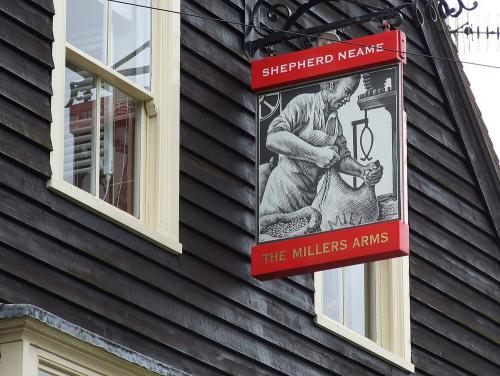
( photo / image / picture from Raddang's Garden ) 2 Tally Ho Many of the smaller pubs are in backstreets set amongst terraced houses. This pub is outside the city wall in what was a very poor locality but is now much smarter. 
( photo / image / picture from Raddang's Garden ) 
( photo / image / picture from Raddang's Garden ) 3 New Inn This must be the smallest pub in the city although just outside the city wall. It is in a backstreet Victorian terraced house. It is noted because it has 7 changing beers meaning that there are always seven on offer but they change frequently. 
( photo / image / picture from Raddang's Garden ) 
( photo / image / picture from Raddang's Garden ) 4 The Two Sawyers This is a one bar pub just outside the city wall set in a row of terraced houses. 
( photo / image / picture from Raddang's Garden ) 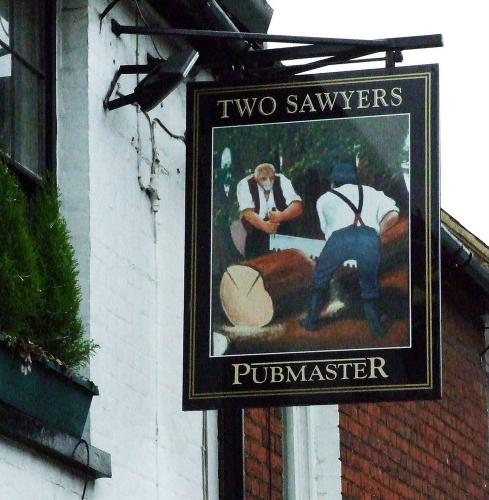
( photo / image / picture from Raddang's Garden ) 5 The Bell and Crown This is a larger traditional pub near the city centre, noted for its ever changing range of local beers. It boasts good views of the Cathedral beyond the boundary wall opposite. 
( photo / image / picture from Raddang's Garden ) 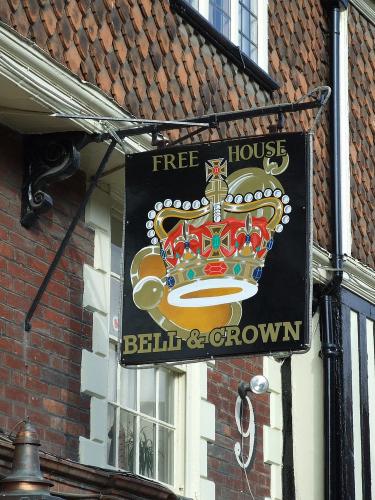
( photo / image / picture from Raddang's Garden ) 6 The Thomas Becket Right in the centre of the city this is a popular pub that specialises in 'Real Ales'. As a resident I get 10% discount there. 
( photo / image / picture from Raddang's Garden ) 
( photo / image / picture from Raddang's Garden ) 7 The Canterbury Tales You can reserve your interval drinks in this charming pub to avoid the crush at the Marlowe theatre right opposite. And they have a bell for when the audience returns. 
( photo / image / picture from Raddang's Garden ) 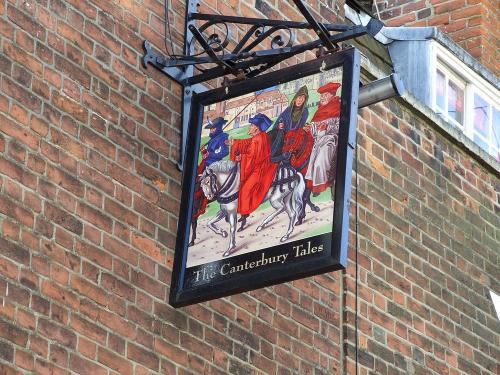
( photo / image / picture from Raddang's Garden ) 8 The Cricketers Situated on St Peters Street, part of the main high street, this is a traditional pub and so much so that I have heard it described as 'a grandads pub'. No TV, just a place to enjoy a drink and to socialise. 
( photo / image / picture from Raddang's Garden ) 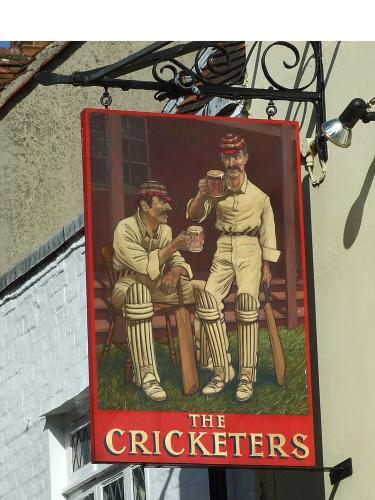
( photo / image / picture from Raddang's Garden ) 9 The White Hart An historic pub just inside the city wall and a stones throw from the Norman Canterbury Castle. 
( photo / image / picture from Raddang's Garden ) 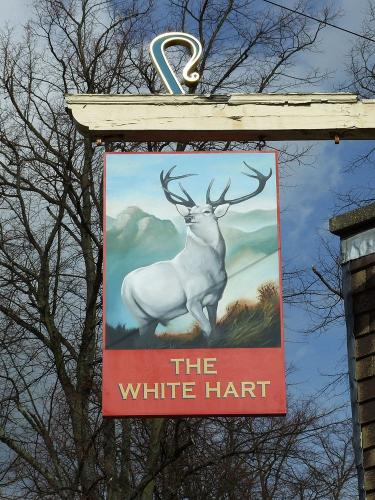
( photo / image / picture from Raddang's Garden ) 10 The Three Tuns A 15th century building in an old area of the city inside the city wall. It is oak beamed with stone flagged floors beneath which are the remains of a Roman theatre. 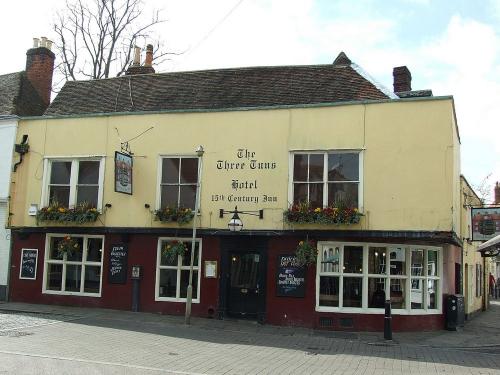
( photo / image / picture from Raddang's Garden ) 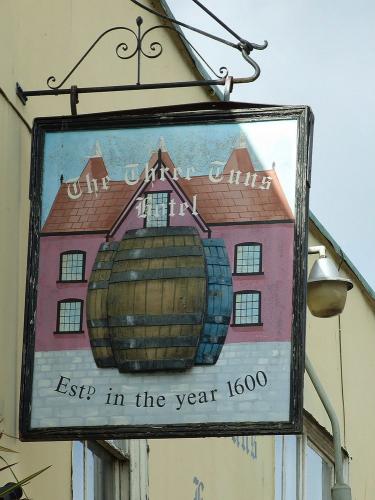
( photo / image / picture from Raddang's Garden ) 11 The Cherry Tree There has been an ale house on this site since 1372. In the city centre, this pub was originally known as The Fleur de Lis Tap but is now a bit over modernised in my opinion. 
( photo / image / picture from Raddang's Garden ) 
( photo / image / picture from Raddang's Garden ) 12 The Old Buttermarket Situated right opposite the main Cathedral entrance at Christ Church Gate, this pub is well located for a drink and a bite to eat after visiting the Cathedral. 
( photo / image / picture from Raddang's Garden ) 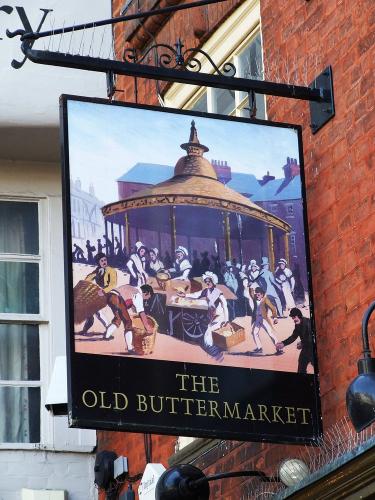
( photo / image / picture from Raddang's Garden ) I picked this Tripadvisor review of The Old Buttermarket, by Dorkon22 from South Carolina, USA, to close my selection of Pubs and their Signs in Canterbury. "I visited for dinner after visiting the Cathedral. Very deceptive from the outside, when you walk back inside it opens up into your stereotypical English pub. My service was excellent. I had the steak and ale pie with a couple of beers. The menu was all one could ask if looking for Pub grub and the beer selection was way over my head. All in all I would highly recommend this as a place for a hearty meal". Last edited: Fri Jul 28, 2017 10:12 pm This blog entry has been viewed 305 times
An English Village and its Pub
Category: The County of Kent and Beyond | Posted: Mon Feb 20, 2017 3:35 pm An English Village and its Pub I count myself fortunate to live in the South East of England in the county of Kent, popularly known as 'The Garden of England'. We like to think that we get the best of the UK weather, we have many sandy beaches with Blue Flags for safe bathing, farming is mostly fruit and veg, and sheep. We are also just 20 miles or so across the English Channel from mainland Europe and the place where the Romans landed in the first century AD. Much of the history of the area has come about due to invasions from Scandinavia, France and Italy. Within a radius of about 15 miles of my home I have many villages and hamlets with populations of a few dozen to a few hundred people. These originate from their location, be it on a river, or pilgrims route, or Roman road, or coaching route. A typical village would include a public space (the village green), the church and rectory, the squire or local land owners house, workers cottages, and of course an inn (now the village pub). Larger villages may also have a school. Last Saturday we went for lunch to the village pub in Wickhambreaux just 5 miles from the city of Canterbury. This village has about 500 residents, it does have a small village school which is rated exceptional. The village and two others nearby, have a corn mill with water wheels driven by water from a small river. It has its Manor House, Wickham Court, and a lovely little inn, The Rose, dating back to the 1500's. The impressive church dates from the 14th century. It was a dull morning so pictures are not the best quality and the village is spoiled at weekends with so many vehicles around. Some buildings on the edge of the village green 
( photo / image / picture from Raddang's Garden ) The Parish Church of St Andrew 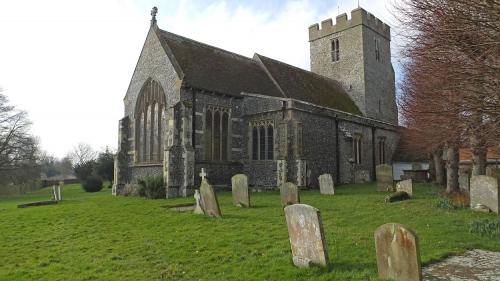
( photo / image / picture from Raddang's Garden ) Wickham Court on the west side of the village green. The facade of this impressive house dates from the 17th century however it is understood that this brickwork covers an earlier medieval building so this is a house with secrets. 
( photo / image / picture from Raddang's Garden ) Wickham Mill, just off the village green. 
( photo / image / picture from Raddang's Garden ) Looking north across the village green. 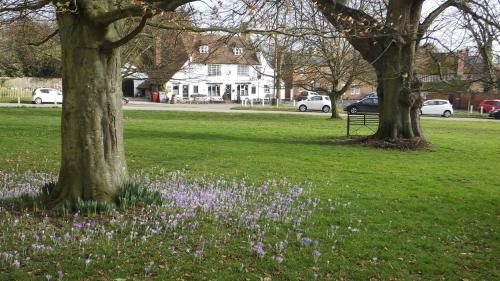
( photo / image / picture from Raddang's Garden ) The Rose Inn circa 1500 
( photo / image / picture from Raddang's Garden ) Inside the pub with open fire and hop vines draped around the ceiling. 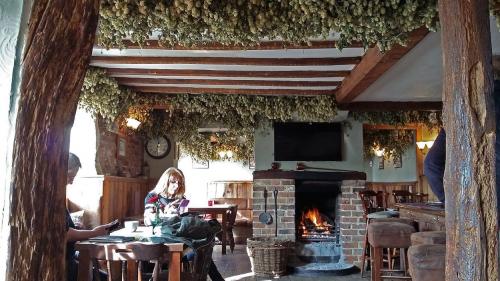
( photo / image / picture from Raddang's Garden ) The quaint bar 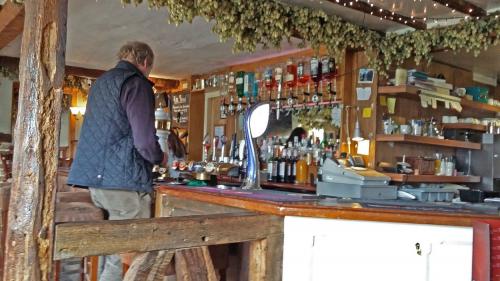
( photo / image / picture from Raddang's Garden ) A simple lunch of cheese and tomato omlette with salad, washed down with some local brew completed our visit to picturesque Wickhambreaux in the county of Kent..... This blog entry has been viewed 288 times
Yet another visit to Canterbury Cathedral
Category: The County of Kent and Beyond | Posted: Sat Dec 03, 2016 9:34 pm I may have mentioned in the past that I live in Canterbury in South East England, the seat of the Archbishop of The Anglican Communion. We have a beautiful Cathedral and, although I am in no way religious, I often visit the Cathedral to explore it and to wonder at the magnificence of this huge Gothic building. As it was a bright sunny morning today I parked right in the city centre for yet another visit. Over recent years the Great South Window, which was in need of restoration, was completely removed. The stone frames and mullions have been replaced and the 13th century stained glass panels have been restored. All the work was completed by the Cathedrals own craftsmen and the window has just been re-instated and it was the window that I wished to see. On arrival at Christchurch Gate, the entrance to the precincts, I was greeted by a group of medieval or more likely Tudor styled musicians and dancers. They were performing in The Buttermarket in the ancient part of the city. 
( photo / image / picture from Raddang's Garden ) On entering the precincts the light was quite good so yet another picture of the whole cathedral. It is so massive that it is difficult to get it all in frame. 
( photo / image / picture from Raddang's Garden ) First a look at the Great South Window from outside. Looking all clean and new and good for many more centuries. 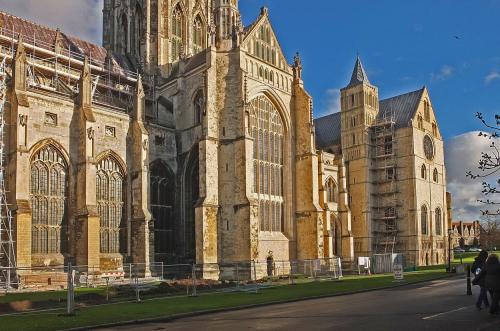
( photo / image / picture from Raddang's Garden ) With the very low bright sun it was difficult to get a true picture of the restored stained glass from inside. The window is 55 x 25 feet so it was a major undertaking to restore the whole window. The cost was ã2.25m which was raised from various donations including the National Lottery and many private donors. Most of the ancient stonework that was removed was sold at auction and the 140 lots realised ã210,000 which will be used in further restoration work at the Cathedral. 
( photo / image / picture from Raddang's Garden ) 
( photo / image / picture from Raddang's Garden ) After restoration some of the glass panels were displayed at J P Getty Museum in LA and also at The Metropolitan Museum in NY. After their return to the Cathedral in 2015 they were put on display in the Chapter House in an exhibition entitled The Ancestors. They were beautifully displayed with back lighting to show the colours of the ancient stained glass. 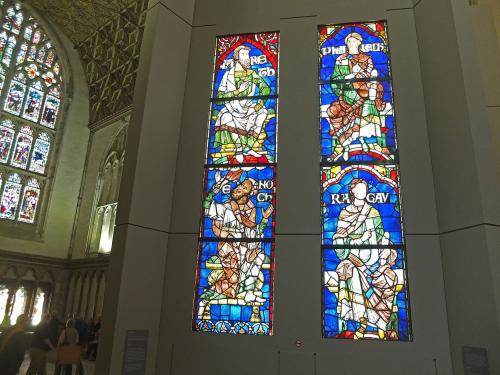
( photo / image / picture from Raddang's Garden ) After being greeted by middle ages music at the gate, the music theme continued inside the Cathedral where a choir from the local public school, Kings, was rehearsing for an upcoming concert. I recorded some video but have posted that in the main forum because video clips cannot be included in blogs. Finally here are a few pictures inside the Cathedral for your interest. There is so much history in this building. In Anglican churches there is very little interior decoration in contrast to the often lavish interiors of Catholic churches. The Cathedral contains tombs, many wall plaques to heroes from the past and of course The Martyrdom, the place where Archbishop Thomas Becket was murdered on 29 December 1170 by followers of King Henry II. Banners on the screen for the St Nicholas service at 1pm 
( photo / image / picture from Raddang's Garden ) View of the Presbytery and Trinity Chapel at the East End of the Cathedral 
( photo / image / picture from Raddang's Garden ) South East Transept with the book of rememberabce. A page is turned at 11am each morning. 
( photo / image / picture from Raddang's Garden ) Looking down the South Aisle of the Nave towards the West Door. 
( photo / image / picture from Raddang's Garden ) I hope you enjoy this snapshot of My Cathedral... This blog entry has been viewed 456 times
Taking pictures
Category: My Occasional Daily Diary | Posted: Sun Aug 28, 2016 4:06 pm I never go anywhere without a camera. My mobile phone is capable of taking very good pictures but most times I prefer to use a 'Proper' camera. I have a selection of three that I use, nothing super expensive; a compact with a short zoom; a DSLR with lenses up to 300mm and a bridge camera with a zoom up to 1000mm. Hardly a day goes by when I don't find something to 'snap' and as a consequence I have tens of thousands of pictures in my digital library. Yesterday afternoon I was sitting out on the patio in the warm sun, camera to hand, hoping that some interesting birds would visit my bird feeding station. 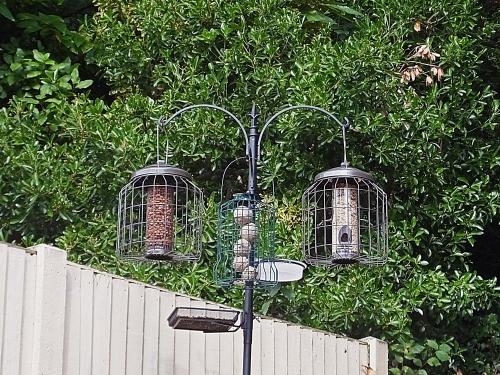
My new bird feeding station ( photo / image / picture from Raddang's Garden ) I think the birds must have all gone on holiday because there were only a few around. No wrens, no bluetits or great tits, no chaffinch or siskin. Just house sparrows, new robins, collared doves and wood pigeons. As I have said, seldom a day passes when I don't get a snap so I just kept a few to include here. [/img] 
Male and female house sparrow ( photo / image / picture from Raddang's Garden ) 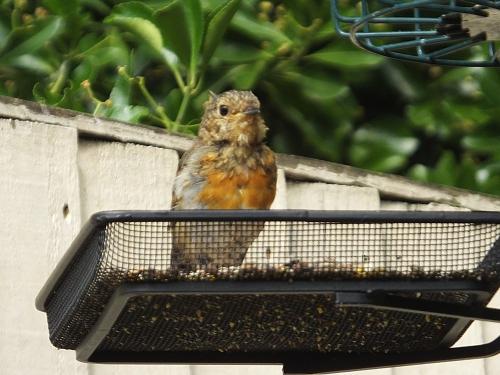
This years robin chick having first moult to show his red breast ( photo / image / picture from Raddang's Garden ) 
One of many collared doves that become quite tame ( photo / image / picture from Raddang's Garden ) 
Woodpigeons know where to find some food ( photo / image / picture from Raddang's Garden ) Perhaps many have found a garden with a better larder Last edited: Sun Aug 28, 2016 4:07 pm This blog entry has been viewed 299 times
Lunch in Herne Bay
Category: The County of Kent and Beyond | Posted: Fri Aug 05, 2016 7:07 pm As I already said in the 'Good Day' thread; Some say TGIF; I say 'what day is it'? The trouble with having been retired for many years you really DO forget what day it is :) Anyhow, nice sunny day so we went off for the short car trip to the North Kent Coast at Herne Bay. This town was once popular with Victorians and Edwardians. It boasted the second longest pier in Britain at about three quarters of a mile. This was necessary due to the very shallow water at low tide and there needed to be enough water for the paddle steamers that called from London to the end of the pier. As a teenager I would go roller skating in the pier pavilion with a group of pals. Sadly the pier was damaged and not repaired. The Pier Pavilion was removed and replaced with a range of craft shacks and a childrens amusements at the end of the remaining shore end structure. The pier head stands in a derelict state three quarters of a mile off the beach. Herne Bay is now well down as a holiday destination but still a pleasant enough place to live. We took a short walk alomg the prom and then had a meze lunch in a Turkish restaurant that looks out to sea. Home by mid afternoon and a couple of hours relaxing in the sun on our patio. Now remind me again.....What day is it. ;-) 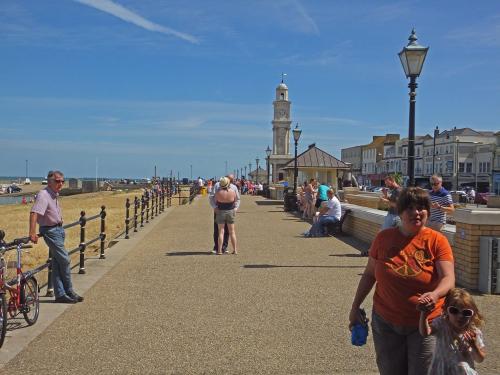
The promenade looking east ( photo / image / picture from Raddang's Garden ) 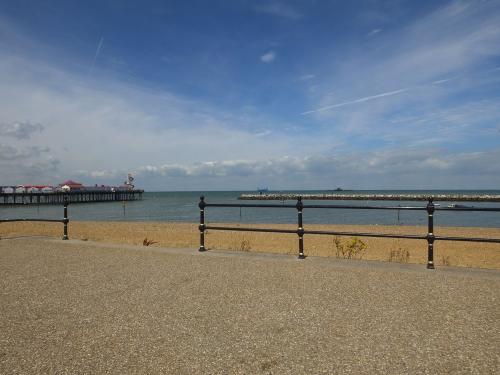
A wide view with the childrens amusements and out to sea, the derelict pier head ( photo / image / picture from Raddang's Garden ) 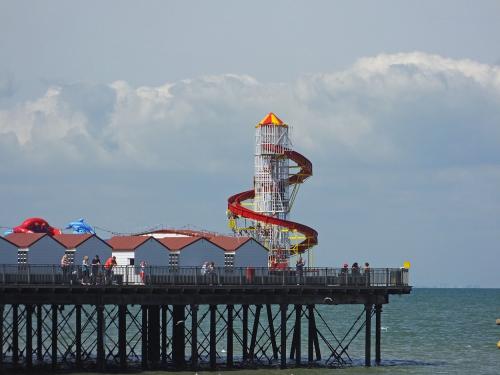
The childrens helter skelter ( photo / image / picture from Raddang's Garden ) 
( photo / image / picture from Raddang's Garden ) 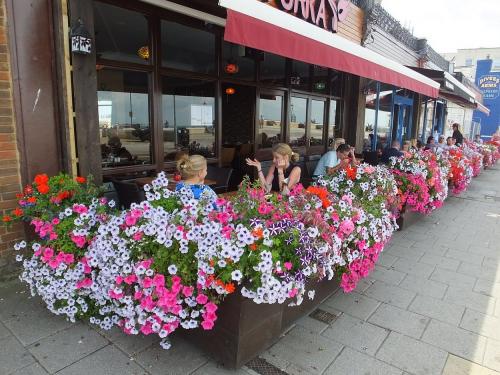
Like having lunch in a flower garden ;-) ( photo / image / picture from Raddang's Garden ) Last edited: Sat Aug 06, 2016 7:37 pm This blog entry has been viewed 276 times
The Crab and Winkle Line
Category: The County of Kent and Beyond | Posted: Mon Aug 01, 2016 2:36 pm THE CRAB AND WINKLE LINE I have mentioned on a number of occasions that I have a former railway embankment right at the end of my small patio garden. This is not within my property but I do keep it clear of the uncontrolled growth of brambles and the like that do occur further along. This is how it looks today. 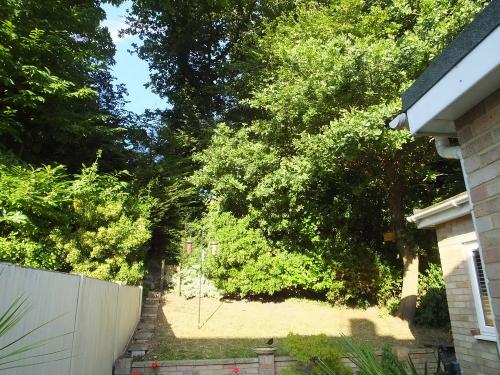
The tree covered embankment ( photo / image / picture from Raddang's Garden ) The railway that once ran along the embankment is significant in railway history for several reasons. When constructed in 1829 it was called the Canterbury and Whitstable Railway, running from West Canterbury the 7 miles to Whitstable Harbour on the North Kent Coast. As visitors to Whitstable enjoyed the extensive local seafood, the line was soon affectionately known as The Crab and Winkle Line. The line was inaugurated on 3 May 1830 and as it operated to a timetable and carried fare paying passengers it has the reputation of being the first public railway in history. The Stockton to Darlington Railway, that started operations in 1825, was originally horse drawn and then when powered by Stephensons Locomotion No 1, it hauled freight and not fare paying passengers although passengers that did travel rode in coal trucks. 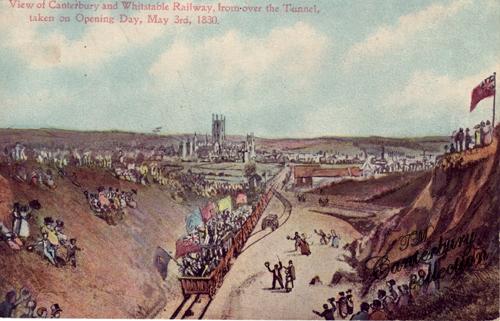
Artists impression of the first journey ( photo / image / picture from Raddang's Garden ) Many say that the Liverpool to Manchester Railway can claim the honour of the worlds first public railway but that was inaugurated on 15 September 1830 so my railway at the bottom of my garden was a worlds first. The last passengers used the line in 1931 and the last coal carrying freight train ran in 1953. The track was removed but the footpath along the trackbed, now much overgrown, is popular with dog walkers. A little further north, the trackbed has been hard surfaced for cyclists and walkers to follow the line of the old railway on to Whitstable. The locomotive which was built for this line was called Invicta. All original locomotives were given names, not numbers. This engine only produced 12 horse power which was not sufficient to haul its train up two slight inclines on the route. This was overcome by the use of a cable between the track that was driven by stationary winding engines, to haul the train. Just beyond where I live there is a hill and this was navigated by digging a tunnel, 764 metres long through the hill. Tunnels had been dug in the canal system but this was the worlds first ever railway tunnel. Here is a selection of my pictures, and some old photos, of points of interest. Some that remain and some that are no longer. 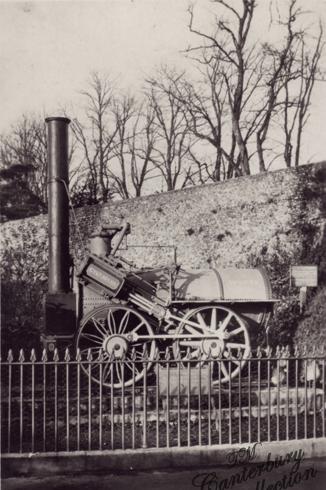
Invicta was displayed just outside the City wall for many years ( photo / image / picture from Raddang's Garden ) 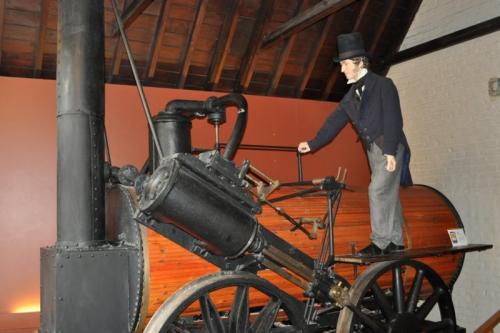
After restoration she is now in The Canterbury Museum ( photo / image / picture from Raddang's Garden ) 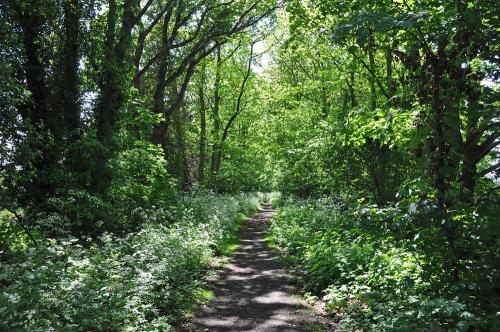
The trackbed footpath today ( photo / image / picture from Raddang's Garden ) 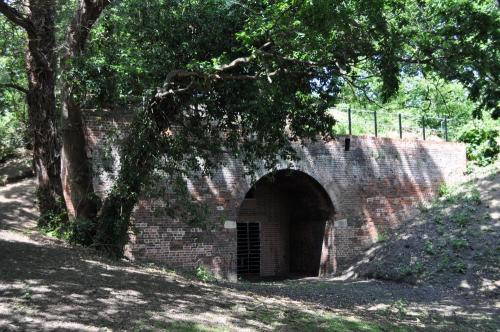
The sealed tunnel entrance ( photo / image / picture from Raddang's Garden ) 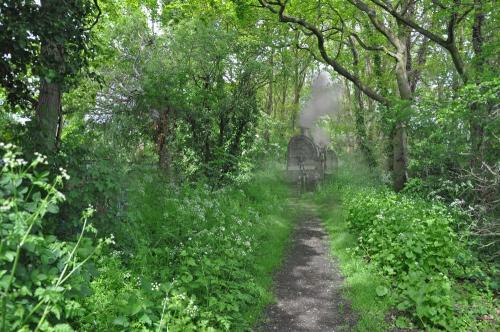
A bit of my ghost train mischief ( photo / image / picture from Raddang's Garden ) 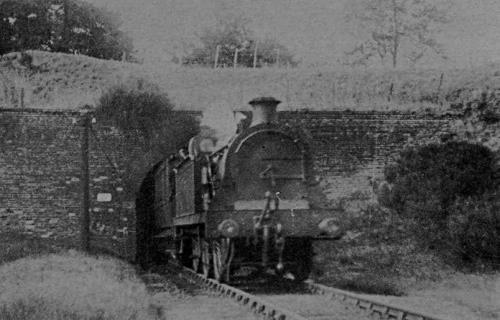
Around 1910 a close fit ( photo / image / picture from Raddang's Garden ) 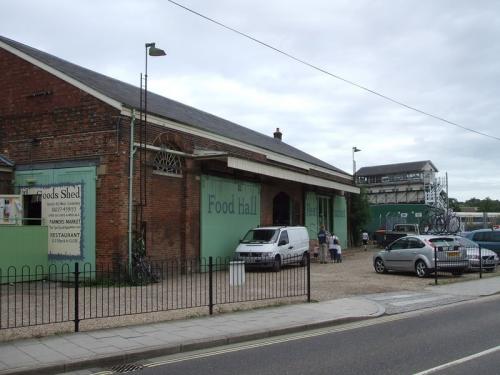
Original goods shed, now a farmers market ( photo / image / picture from Raddang's Garden ) 
Harbourside arrival point circa 1910. Note boy bottom left ( photo / image / picture from Raddang's Garden ) 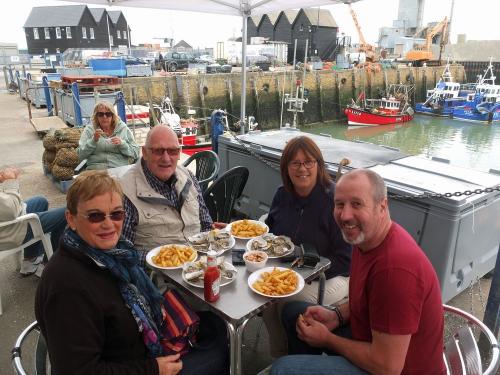
Right where the boy was standing, we often have oysters and chips ;-) ( photo / image / picture from Raddang's Garden ) More about The County of Kent and Beyond to follow This blog entry has been viewed 288 times
Introduction to my Blog
Category: That's life | Posted: Thu Jul 28, 2016 4:12 pm When you get to my age there has been a lot of water flow under the bridge of life. I can add bits and pieces from my recollections in various forum threads but they can lose continuity so I have decided to start a Blog. It is most likely that I shall write under such headings as, Lifetime Experiences, My Working Life, My Childhood in WWII, and My Travel Experiences. The County of Kent and Beyond and An Occasional Daily Diary. I will try to make my entries interesting, if not, they will remain just my thoughts. So, I invite you to "Watch this space" 
( photo / image / picture from Raddang's Garden ) This blog entry has been viewed 335 times
You're reading one of many blogs on GardenStew.com.
Register for free and start your own blog today. |
Entries by Category
All Categories
|
